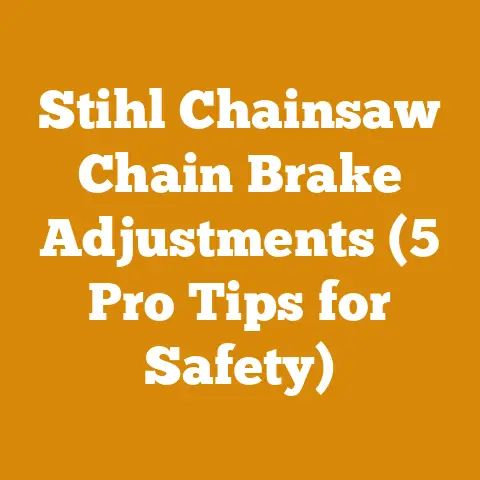Wooden Truck Bed Prefab (7 Pro Tips for Durable Woodwork)
The old adage “measure twice, cut once” rings especially true when you’re staring down the barrel of a woodworking project like building a wooden truck bed. It’s not just about the perfect cut; it’s about understanding the costs involved, the challenges you might face, and how to build something that lasts. I’ve spent years knee-deep in sawdust, from felling trees in the crisp morning air to splitting firewood under the blazing summer sun. And trust me, I’ve learned a thing or two about budgeting and building with wood the hard way. So, let’s dive into the nitty-gritty of crafting a durable wooden truck bed, focusing on those critical cost considerations and pro tips to ensure your project stands the test of time and doesn’t break the bank.
Wooden Truck Bed Prefab: 7 Pro Tips for Durable Woodwork and Cost-Effective Construction
Building a wooden truck bed isn’t just about aesthetics; it’s about functionality, durability, and, let’s be honest, making a statement. It’s a project that can range from a weekend warrior’s DIY endeavor to a professional undertaking. Either way, understanding the costs and how to manage them is paramount. Here’s a breakdown, peppered with my own experiences and some hard-won wisdom.
1. Planning and Design: Laying the Foundation for Savings
Before you even think about touching a piece of lumber, you need a solid plan. This is where the “measure twice, cut once” philosophy truly begins.
- Understanding Your Needs: What will you be hauling? Heavy loads, light loads, long loads? This dictates the type of wood, the thickness required, and the overall design. I remember one time, I underestimated the weight I’d be hauling with a bed I built for my old pickup. The result? A sagging bed and a costly rebuild.
- Design Considerations: A well-thought-out design optimizes material use and reduces waste. Consider factors like bed size, side rail height, and the need for tie-down points.
- Cost Implications: Time spent planning saves money later. Poor planning leads to wasted materials, rework, and potential structural failures.
- Actionable Steps: Sketch your design, noting dimensions and material requirements. Research existing truck bed designs for inspiration and identify potential problem areas. Use software like SketchUp (free version available) for a 3D model.
2. Choosing the Right Wood: The Heart of Your Truck Bed’s Durability and Cost
The type of wood you choose is arguably the most critical factor influencing both the durability and the cost of your truck bed.
- Wood Species:
- Hardwoods (Oak, Maple, Ash): Offer superior strength and durability but come with a higher price tag. Oak, for example, is incredibly strong and rot-resistant but can be difficult to work with due to its density. I once built a workbench out of oak, and let me tell you, every screw felt like a battle won.
- Softwoods (Pine, Fir, Cedar): More affordable and easier to work with, but less durable. Pine is a common choice, but it needs to be properly treated to prevent rot and insect damage. Cedar is naturally rot-resistant, making it a good option for areas with high moisture.
- Treated Lumber: Pressure-treated lumber is a cost-effective option for resisting rot and insect damage, but it can be less aesthetically pleasing and may require special handling due to the chemicals used in the treatment process.
- Wood Quality: Look for lumber that is straight, free of knots, and properly dried. Warped or knotty lumber will be harder to work with and may compromise the structural integrity of your bed.
- Cost Analysis: Prices fluctuate based on region, availability, and grade. Call local lumberyards for quotes and compare prices.
- Data Point: As of late 2024, rough-sawn oak can range from $4 to $8 per board foot, while pine can be found for $1 to $3 per board foot. Treated lumber typically falls in the $2 to $5 range. These are averages; prices can vary significantly.
- Personal Experience: I’ve found that spending a little extra on higher-quality lumber pays off in the long run. A truck bed built with cheap, knotty pine might look good at first, but it won’t hold up to the rigors of daily use.
- Actionable Steps: Research the properties of different wood species and their suitability for truck bed construction. Get quotes from multiple lumberyards and inspect the lumber before you buy it. Consider the long-term cost of maintenance and replacement when making your decision.
3. Calculating Material Costs: From Lumber to Fasteners
Accurately estimating material costs is crucial for staying within budget.
- Lumber Calculations: Determine the board footage required for your design. This involves calculating the volume of each piece of lumber and summing them up. Remember the formula: Board Feet = (Thickness in inches x Width in inches x Length in feet) / 12.
- Fasteners: Screws, bolts, and nails are essential for holding everything together. Use high-quality, exterior-grade fasteners to prevent rust and corrosion.
- Data Point: A box of 100 exterior-grade screws can range from $10 to $30, depending on the size and type.
- Finishes and Sealants: Protect your wood from the elements with a good quality sealant or paint. This will extend the life of your truck bed and prevent rot and decay.
- Data Point: A gallon of exterior-grade sealant can cost anywhere from $30 to $100, depending on the brand and type.
- Hardware: Hinges, latches, and tie-down points add functionality and security. Choose hardware that is designed for outdoor use and can withstand heavy loads.
- Data Point: A set of four heavy-duty tie-down points can cost from $20 to $50.
- Waste Factor: Always add a waste factor to your material estimates. Woodworking inevitably involves some amount of waste due to cuts, mistakes, and unusable pieces. A 10-15% waste factor is a good rule of thumb.
- Detailed Example:
- Let’s say you need 10 pieces of lumber that are 2 inches thick, 6 inches wide, and 8 feet long.
- Board Feet per piece = (2 x 6 x 8) / 12 = 8 board feet
- Total Board Feet = 8 board feet x 10 pieces = 80 board feet
- If the lumber costs $5 per board foot, the total lumber cost would be $400.
- Adding a 10% waste factor, you would need to purchase 88 board feet, bringing the lumber cost to $440.
- Actionable Steps: Create a detailed materials list, including dimensions, quantities, and prices. Contact multiple suppliers for quotes and factor in shipping costs. Don’t forget to add a waste factor to your estimates.
4. Tooling Up: Investing in the Right Equipment
Having the right tools makes the job easier, safer, and more efficient.
- Essential Tools:
- Circular Saw: For making straight cuts. A good quality circular saw is a must-have for any woodworking project.
- Jigsaw: For making curved cuts and intricate shapes.
- Drill/Driver: For drilling holes and driving screws.
- Sander: For smoothing surfaces and preparing them for finishing.
- Measuring Tools: A tape measure, level, and square are essential for accurate measurements and alignment.
- Optional Tools:
- Table Saw: Provides more precise and efficient straight cuts than a circular saw.
- Planer: For smoothing and flattening lumber.
- Router: For creating decorative edges and grooves.
- Rental vs. Purchase: Consider renting tools that you don’t use frequently. This can save you money and storage space.
- Data Point: Renting a table saw for a day can cost $50 to $100, while purchasing a new table saw can cost $300 to $1000 or more.
- Tool Maintenance: Keep your tools clean and well-maintained. This will extend their life and improve their performance. Sharpen blades regularly and lubricate moving parts.
- Cost-Saving Tips:
- Buy used tools. You can often find good quality used tools at a fraction of the price of new ones.
- Borrow tools from friends or family.
- Take advantage of tool rental programs offered by hardware stores.
- Personal Anecdote: I once tried to build a deck using only a hand saw. Let me tell you, it was a grueling experience that took far longer than it should have. Investing in a good circular saw would have saved me a lot of time and effort.
- Actionable Steps: Make a list of the tools you will need for your project. Determine which tools you already own and which ones you need to purchase or rent. Research prices and compare options. Factor in the cost of maintenance and repairs.
5. Labor Costs: DIY vs. Hiring a Professional
If you’re not comfortable doing the work yourself, you’ll need to factor in labor costs.
- DIY: If you’re doing the work yourself, you’ll save on labor costs, but you’ll need to factor in your time. Consider how long the project will take and whether you have the skills and experience to do it properly.
- Hiring a Professional: Hiring a professional carpenter or woodworker can ensure a high-quality result, but it will add significantly to the cost of your project.
- Data Point: The hourly rate for a carpenter can range from $30 to $100, depending on their experience and location.
- Factors Affecting Labor Costs:
- Complexity of the Design: A more complex design will require more labor and skill.
- Accessibility: If your truck is difficult to access, it will take longer to complete the project.
- Experience of the Carpenter: More experienced carpenters will charge higher rates.
- Getting Quotes: Get quotes from multiple carpenters and compare their prices. Be sure to ask for references and check their previous work.
- Cost-Saving Tips:
- Do some of the work yourself, such as demolition or cleanup.
- Provide the carpenter with a detailed plan and materials list.
- Be flexible with the schedule.
- My Experience: I’ve always been a DIYer at heart, but there are times when it’s worth hiring a professional. For example, I once hired a carpenter to build a custom cabinet for my workshop. It was a complex project that required specialized skills and tools, and the carpenter did an excellent job.
- Actionable Steps: Determine whether you will do the work yourself or hire a professional. If you’re hiring a professional, get quotes from multiple carpenters and compare their prices.
6. Finishing and Protection: Ensuring Longevity
The finish you apply to your wooden truck bed is crucial for protecting it from the elements and extending its lifespan.
- Types of Finishes:
- Sealants: Penetrate the wood and provide a water-resistant barrier.
- Paints: Provide a protective coating and add color.
- Stains: Enhance the natural beauty of the wood and provide some protection.
- Varnishes: Provide a durable, glossy finish.
- Choosing the Right Finish: Consider the climate, the type of wood, and the desired aesthetic. In areas with high moisture, a sealant is essential. If you want to add color, paint is a good option.
- Application Techniques: Follow the manufacturer’s instructions carefully. Apply multiple coats for maximum protection.
- Cost Considerations:
- Material Costs: The cost of finishes can vary widely depending on the type and quality.
- Labor Costs: Applying a finish can be time-consuming, especially if you’re doing it yourself.
- Maintenance: Reapply the finish every few years to maintain its protective properties.
- Data Point: A gallon of exterior-grade paint can cost anywhere from $30 to $100, while a gallon of sealant can cost from $40 to $120.
- Personal Story: I once built a picnic table and applied a cheap, water-based sealant. Within a year, the sealant had peeled off, and the wood was starting to rot. I learned my lesson and now only use high-quality, oil-based sealants for outdoor projects.
- Actionable Steps: Research different types of finishes and choose the one that is best suited for your needs. Follow the manufacturer’s instructions carefully and apply multiple coats.
7. Permits and Regulations: Staying Legal and Avoiding Fines
Depending on your location, you may need permits to build a wooden truck bed.
- Local Regulations: Check with your local building department to determine if any permits are required.
- Safety Standards: Ensure that your truck bed meets all applicable safety standards.
- Cost Implications: Permit fees can vary widely depending on the location and the scope of the project.
- Consequences of Non-Compliance: Building without a permit can result in fines, stop-work orders, and even legal action.
- Research is Key: Don’t assume that you don’t need a permit. Do your research and make sure you’re in compliance with all applicable regulations.
- Data Point: Permit fees can range from $50 to $500 or more, depending on the location and the scope of the project.
- My Advice: It’s always better to be safe than sorry. Take the time to research local regulations and obtain any necessary permits before starting your project.
- Actionable Steps: Contact your local building department and inquire about permit requirements. Research applicable safety standards.
Cost Optimization: Squeezing the Most Out of Your Budget
Now, let’s talk about squeezing every last drop of value from your budget.
- Bulk Buying: Purchase lumber and fasteners in bulk to save money.
- Salvaged Materials: Consider using salvaged lumber or hardware. You can often find good quality materials at a fraction of the price of new ones.
- Negotiating Prices: Don’t be afraid to negotiate prices with suppliers.
- DIY Labor: Do as much of the work yourself as possible.
- Efficient Design: Design your truck bed to minimize material waste.
- Phased Approach: Break the project into smaller, more manageable phases. This can help you spread out the costs over time.
- Value Engineering: Look for ways to reduce costs without compromising quality or durability.
- Cost-Benefit Analysis: Evaluate the costs and benefits of different options before making a decision.
- Personal Experience: I once built a shed using mostly salvaged materials. It took a little more time and effort, but I saved a significant amount of money.
- Actionable Steps: Implement these cost optimization strategies to save money on your truck bed project.
Budgeting: Keeping Track of Your Spending
Creating a budget and sticking to it is essential for staying on track.
- Create a Detailed Budget: List all of the anticipated costs, including materials, tools, labor, permits, and finishes.
- Track Your Spending: Keep track of your actual spending and compare it to your budget.
- Identify Variances: If you’re over budget, identify the reasons why and take corrective action.
- Contingency Fund: Set aside a contingency fund to cover unexpected costs.
- Regular Review: Review your budget regularly and make adjustments as needed.
- Budgeting Tools: Use budgeting software or spreadsheets to help you manage your finances.
- Data Point: A contingency fund of 10-15% is a good rule of thumb.
- My Tip: Don’t underestimate the importance of tracking your spending. It’s easy to lose track of where your money is going if you’re not careful.
- Actionable Steps: Create a detailed budget, track your spending, and review your budget regularly.
Case Studies: Learning from Others’ Experiences
Let’s examine a couple of hypothetical case studies to illustrate the principles we’ve discussed.
- Case Study 1: The Budget-Conscious DIYer
- Goal: Build a basic wooden truck bed for hauling light loads.
- Approach: Uses pine lumber, salvaged hardware, and DIY labor.
- Budget: $500
- Challenges: Limited budget, potential for lower durability.
- Solutions: Careful planning, efficient design, and cost optimization strategies.
- Case Study 2: The Professional-Grade Project
- Goal: Build a heavy-duty wooden truck bed for hauling heavy loads.
- Approach: Uses oak lumber, high-quality hardware, and professional labor.
- Budget: $2000
- Challenges: Higher costs, potential for overspending.
- Solutions: Detailed budgeting, competitive bidding, and value engineering.
- Key Takeaways: These case studies illustrate the importance of tailoring your approach to your specific goals and budget.
- Actionable Steps: Analyze these case studies and apply the lessons learned to your own project.
Final Thoughts: Building a Legacy
Building a wooden truck bed is more than just a woodworking project; it’s an investment in functionality, durability, and personal satisfaction. By understanding the costs involved, planning carefully, and implementing cost optimization strategies, you can build a truck bed that will last for years to come. Remember, the “measure twice, cut once” principle applies not only to woodworking but also to budgeting and cost management.
From my years of experience, I can tell you that the satisfaction of building something with your own hands is truly rewarding. It’s a feeling that can’t be bought. So, gather your tools, do your research, and get ready to build a wooden truck bed that you can be proud of. And remember, the journey is just as important as the destination. Happy woodworking!






